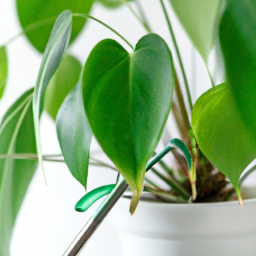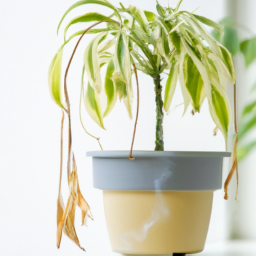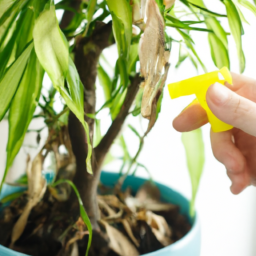
Are you one of those people who absolutely love having indoor plants but suffer from allergies every time you bring one home? If so, you’re not alone. Combatting indoor plant allergies can be a frustrating challenge for many plant enthusiasts. The good news is, there are effective ways to enjoy the beauty and benefits of indoor plants without constantly sneezing or dealing with itchy eyes. In this blog post, we will explore some practical tips and strategies to help you combat indoor plant allergies and create a healthier and more enjoyable environment for both you and your plants. So, let’s dive in and discover how you can coexist peacefully with your leafy companions!
Understanding Indoor Plant Allergies: Causes, Symptoms, and Prevention
Welcome to our comprehensive guide on combatting indoor plant allergies. In this article, we will explore the causes, symptoms, and prevention strategies for dealing with indoor plant allergies. Whether you are a seasoned plant lover or just starting to bring greenery into your home, it is essential to understand how to combat allergies to ensure a healthy and enjoyable indoor environment.
Causes of Indoor Plant Allergies
Indoor plant allergies can be triggered by various factors. The most common cause is pollen released by flowering plants. Pollen is a fine powder produced by the male parts of flowers and can easily become airborne. When inhaled, pollen can cause allergic reactions in susceptible individuals. Additionally, mold spores and dust mites can accumulate on the leaves and in the soil of indoor plants, further exacerbating allergies.
Another factor to consider is the presence of volatile organic compounds (VOCs) emitted by certain plants. These compounds can irritate the respiratory system and trigger allergic reactions in some individuals. It is important to note that not all plants release significant amounts of VOCs, and the severity of the reaction can vary from person to person.
To identify the specific cause of your indoor plant allergies, it is recommended to consult with an allergist who can conduct tests and provide personalized advice.
Symptoms of Indoor Plant Allergies
The symptoms of indoor plant allergies can range from mild to severe, depending on the individual’s sensitivity and the allergen’s concentration. Common symptoms include:
- Nasal congestion and runny nose
- Sneezing and coughing
- Itchy and watery eyes
- Shortness of breath or wheezing
- Skin rashes or hives
If you experience any of these symptoms when exposed to indoor plants, it is likely that you have an allergy. It is essential to pay attention to these signs and take appropriate measures to combat indoor plant allergies.
Prevention Strategies for Indoor Plant Allergies
Combatting indoor plant allergies requires a multi-faceted approach that includes minimizing allergen exposure and creating a healthy indoor environment. Here are some effective prevention strategies:
1. Choose Low-Allergen Plants: Opt for plants that have low pollen production and minimal VOC emissions. Examples include ferns, palms, succulents, and snake plants. Research the specific allergenic properties of plants before bringing them into your home.
2. Maintain Good Indoor Air Quality: Regularly ventilate your living space to reduce the concentration of allergens. Use air purifiers with HEPA filters to capture pollen, mold spores, and other airborne allergens. Keep humidity levels between 30-50% to discourage mold growth.
3. Clean and Dust Regularly: Dust the leaves of your indoor plants frequently to remove allergens. Use a damp cloth or sponge to avoid dispersing pollen into the air. Vacuum your home regularly, especially if you have carpeted areas that can trap dust and allergens.
4. Create Allergy-Free Zones: Designate specific areas in your home as “allergy-free zones” where no plants are allowed. This can be particularly beneficial for individuals with severe allergies or asthma.
5. Consider Allergy Medications: Over-the-counter antihistamines and nasal sprays can provide temporary relief from allergy symptoms. Consult with a healthcare professional to determine the most suitable medication for your specific needs.
6. Regularly Monitor and Maintain Plants: Keep an eye out for signs of mold growth or pest infestations on your indoor plants. Promptly address any issues to prevent the worsening of allergies. Ensure proper drainage to avoid stagnant water that can attract mold.
7. Consult an Allergist: If your indoor plant allergies persist or worsen despite taking preventive measures, it is advisable to seek professional help. An allergist can conduct tests to identify specific allergens and provide personalized advice on managing your allergies.
By following these prevention strategies, you can create a healthy indoor environment that allows you to enjoy the benefits of indoor plants without suffering from allergies. Remember, each individual’s allergies are unique, so it is essential to find the approach that works best for you. With proper care and attention, you can combat indoor plant allergies and continue to surround yourself with the beauty of nature indoors.

Effective Strategies for Reducing Indoor Plant Allergies
As an expert in combatting indoor plant allergies, I understand the challenges faced by individuals who love having plants indoors but struggle with allergies. Allergies caused by indoor plants can be quite bothersome, leading to symptoms such as sneezing, coughing, itchy eyes, and even difficulty breathing. However, fear not! With a few effective strategies, you can still enjoy the beauty of indoor plants while minimizing the risk of allergies. In this guide, I will provide you with step-by-step instructions on how to combat indoor plant allergies.
Identify Allergy-Triggering Plants
The first step in combatting indoor plant allergies is to identify which plants are triggering your symptoms. Not all plants cause allergies, so it’s essential to determine which ones are causing your discomfort. Some common indoor plants known to trigger allergies include:
- Pollen-producing plants such as certain types of ferns, palms, and orchids.
- Plants with strong fragrances like jasmine, gardenia, and lilies.
- Plants with tiny hairs on their leaves or stems, such as African violets and begonias.
By identifying the specific plants that trigger your allergies, you can take appropriate measures to combat them effectively.
Opt for Low-Allergen Plants
If you still want to enjoy indoor plants without the risk of allergies, consider opting for low-allergen plants. These plants have minimal pollen production and are less likely to cause allergic reactions. Some examples of low-allergen plants include:
- Spider plants (Chlorophytum comosum)
- Snake plants (Sansevieria trifasciata)
- Areca palms (Dypsis lutescens)
- Bamboo palms (Chamaedorea seifrizii)
These plants not only add beauty to your indoor space but also help purify the air, making them an excellent choice for allergy sufferers.
Proper Plant Placement
Where you place your indoor plants can significantly impact your allergies. By strategically positioning your plants, you can reduce the risk of allergens affecting your breathing space. Here are some tips:
- Avoid placing plants in your bedroom or areas where you spend a significant amount of time.
- Keep plants away from windows and doors to prevent pollen from entering your home.
- Consider using a plant stand or shelf to elevate your plants, keeping them away from your immediate breathing zone.
Proper plant placement can help create a healthier indoor environment, minimizing the chances of allergy symptoms.
Maintain Good Indoor Air Quality
Improving indoor air quality is crucial for combatting indoor plant allergies. Here are some steps you can take:
- Regularly dust and clean your indoor plants to remove any accumulated allergens.
- Use a high-quality air purifier with a HEPA filter to trap airborne allergens.
- Keep your home well-ventilated by opening windows or using fans to circulate fresh air.
- Consider installing a dehumidifier to control humidity levels, as excessive moisture can promote mold growth.
By maintaining good indoor air quality, you can create a more allergy-friendly environment, even with indoor plants.
Personal Allergy Management
Finally, it’s essential to take personal allergy management steps to combat indoor plant allergies effectively. Here are some recommendations:
- Wash your hands thoroughly after touching plants to remove any allergens.
- Avoid touching your face, especially your eyes, while handling plants.
- Consider wearing a mask or using a nasal spray during plant maintenance to reduce allergen exposure.
- Consult with an allergist to explore medication options or allergy immunotherapy if your symptoms persist.
Personal allergy management, combined with the strategies mentioned above, can significantly alleviate indoor plant allergy symptoms.
By following these step-by-step strategies, you can combat indoor plant allergies and enjoy the benefits of having plants in your home. Remember, it’s all about identifying allergy triggers, choosing low-allergen plants, proper plant placement, maintaining good indoor air quality, and taking personal allergy management steps. With these effective strategies, you can create an allergy-friendly indoor environment that allows you to enjoy the beauty of indoor plants without the discomfort of allergies.

Selecting Allergy-Friendly Indoor Plants: A Guide for Allergy Sufferers
Indoor plants not only add beauty and freshness to our living spaces but also provide numerous health benefits. However, for individuals with allergies, certain plants can trigger unpleasant symptoms. If you are an allergy sufferer, fret not! In this guide, we will walk you through the process of selecting allergy-friendly indoor plants to combat indoor plant allergies effectively.
Understanding Indoor Plant Allergies
Before delving into the selection process, it’s crucial to understand what causes indoor plant allergies. Allergies to indoor plants are primarily triggered by pollen, mold spores, and certain chemicals emitted by the plants. When these allergens come into contact with sensitive individuals, they can lead to symptoms such as sneezing, itchy eyes, nasal congestion, and even difficulty breathing.
To combat indoor plant allergies, it’s essential to choose plants that have minimal pollen production, low mold susceptibility, and emit fewer volatile organic compounds (VOCs). Let’s explore the steps to select allergy-friendly indoor plants:
Step 1: Research Low-Pollen Plants
Start by researching indoor plants that have low pollen production. Pollen is a common allergen that can cause significant discomfort for allergy sufferers. Opt for plants that have flowers with low pollen counts or plants that are known to be pollinated by insects rather than wind. Some examples of low-pollen indoor plants include snake plants, peace lilies, and bromeliads.
Additionally, consider plants with larger and waxy flowers, as they are less likely to release pollen into the air. These types of flowers rely on insects for pollination, reducing the risk of pollen exposure for allergy sufferers.
Furthermore, avoid plants that are known to be highly allergenic, such as ragweed, chamomile, and chrysanthemums. These plants can exacerbate allergy symptoms and should be avoided in allergy-friendly indoor environments.
Step 2: Mold-Resistant Plants
Mold spores are another common trigger for indoor plant allergies. Mold thrives in damp environments, making it essential to choose mold-resistant plants. Look for plants that prefer drier soil conditions and have good drainage. These plants are less likely to develop mold issues, reducing the risk of mold spores in the air.
Air-purifying plants such as spider plants, Boston ferns, and English ivy are not only known for their ability to remove toxins from the air but also tend to be less susceptible to mold growth. These plants can be excellent choices for allergy sufferers looking to combat indoor plant allergies.
Remember to avoid overwatering your plants, as excessive moisture can create a favorable environment for mold growth. Ensure proper ventilation in your indoor space to keep the air circulating and prevent excess humidity.
Step 3: Low-VOC Plants
Indoor plants can release volatile organic compounds (VOCs), which can cause irritation and allergic reactions in some individuals. To minimize exposure to VOCs, choose plants that have low emissions of these compounds.
Plants such as aloe vera, spider plants, and bamboo palms are known for their ability to absorb and filter harmful chemicals from the air, including VOCs. These plants not only enhance indoor air quality but also have lower emission levels compared to other plant varieties.
It’s important to note that some individuals may have specific sensitivities to certain plants, even if they are generally considered low-VOC. If you experience any adverse reactions, consider removing the plant from your indoor space and consult with a healthcare professional if necessary.
In conclusion, combatting indoor plant allergies involves selecting allergy-friendly plants that have low pollen production, are mold-resistant, and emit fewer volatile organic compounds. By following these steps, you can create an indoor environment that promotes better air quality and reduces the risk of allergy symptoms. Remember to research specific plant varieties and consult with experts if needed to ensure your indoor space remains comfortable and allergy-friendly.
Let’s wrap up what we learned
Indoor plants are a great way to bring a touch of nature into our homes, but for some people, they can also trigger annoying allergies. If you find yourself sneezing, coughing, or experiencing itchy eyes whenever you’re near indoor plants, don’t worry, you’re not alone. In this blog post, we will explore some effective ways to combat indoor plant allergies and still enjoy the benefits of having greenery in your home.
First and foremost, it’s important to identify the specific plants that are causing your allergies. Not all plants produce the same allergens, so knowing which ones to avoid can make a big difference. Some common culprits include pollen-heavy plants like lilies, daisies, and sunflowers. If you’re unsure which plants are triggering your allergies, consider consulting an allergist who can perform tests to pinpoint the exact cause. Once you know which plants to steer clear of, you can opt for low-allergen alternatives such as spider plants, peace lilies, or snake plants, which are known to have lower pollen production. Additionally, regularly dusting the leaves of your indoor plants and keeping them clean can help reduce allergens in the air.
Here are some questions from our readers:
Q1: What are indoor plant allergies and how do they affect people?
A1: Indoor plant allergies refer to allergic reactions that occur when individuals come into contact with certain plants or their pollen, mold, or other allergens present in the indoor environment. These allergies can affect people in various ways, such as triggering symptoms like sneezing, coughing, itchy and watery eyes, nasal congestion, skin rashes, or even asthma attacks in susceptible individuals.
Q2: Which indoor plants are more likely to cause allergies?
A2: While everyone’s sensitivity to allergens can vary, some indoor plants are more likely to cause allergies than others. Common culprits include plants such as certain types of ferns, ficus trees, palms, and flowers like chrysanthemums or daisies. However, it’s important to note that not all individuals will react to the same plants, and some people may not experience any allergies at all.
Q3: How can I reduce indoor plant allergies?
A3: To combat indoor plant allergies, there are several measures you can take. Firstly, consider choosing plants that are known to be hypoallergenic, such as snake plants, spider plants, or peace lilies. These plants produce less pollen and have lower chances of triggering allergies. Additionally, regularly dusting and wiping down the leaves of your indoor plants can help remove any allergens that may have accumulated. It’s also advisable to keep plants out of bedrooms or other areas where you spend a lot of time, especially if you’re particularly sensitive to allergens.
Q4: Can air purifiers help with indoor plant allergies?
A4: Yes, air purifiers can be beneficial in reducing indoor plant allergies. High-quality air purifiers with HEPA filters can effectively capture and remove airborne allergens, including pollen, mold spores, and other plant-related allergens. By running an air purifier in the same room as your indoor plants, you can help reduce the concentration of allergens in the air, providing relief for allergy sufferers.
Q5: Are there any alternative solutions for combatting indoor plant allergies?
A5: In addition to hypoallergenic plants and air purifiers, there are other alternative solutions you can try. One option is to use natural remedies like saline nasal rinses or nasal sprays to alleviate congestion and reduce allergy symptoms. You can also consult with an allergist who can provide specific advice tailored to your situation. They may recommend allergy medications or immunotherapy, such as allergy shots, to help desensitize your body to plant allergens over time.

Lisa Chen is a seasoned indoor gardening expert and the author of several bestselling books on the topic. With a background in horticulture and urban farming, Lisa is dedicated to helping urban dwellers embrace the joys of cultivating green spaces indoors. Her detailed guides and hands-on tips empower readers to transform their living spaces into thriving plant sanctuaries.


